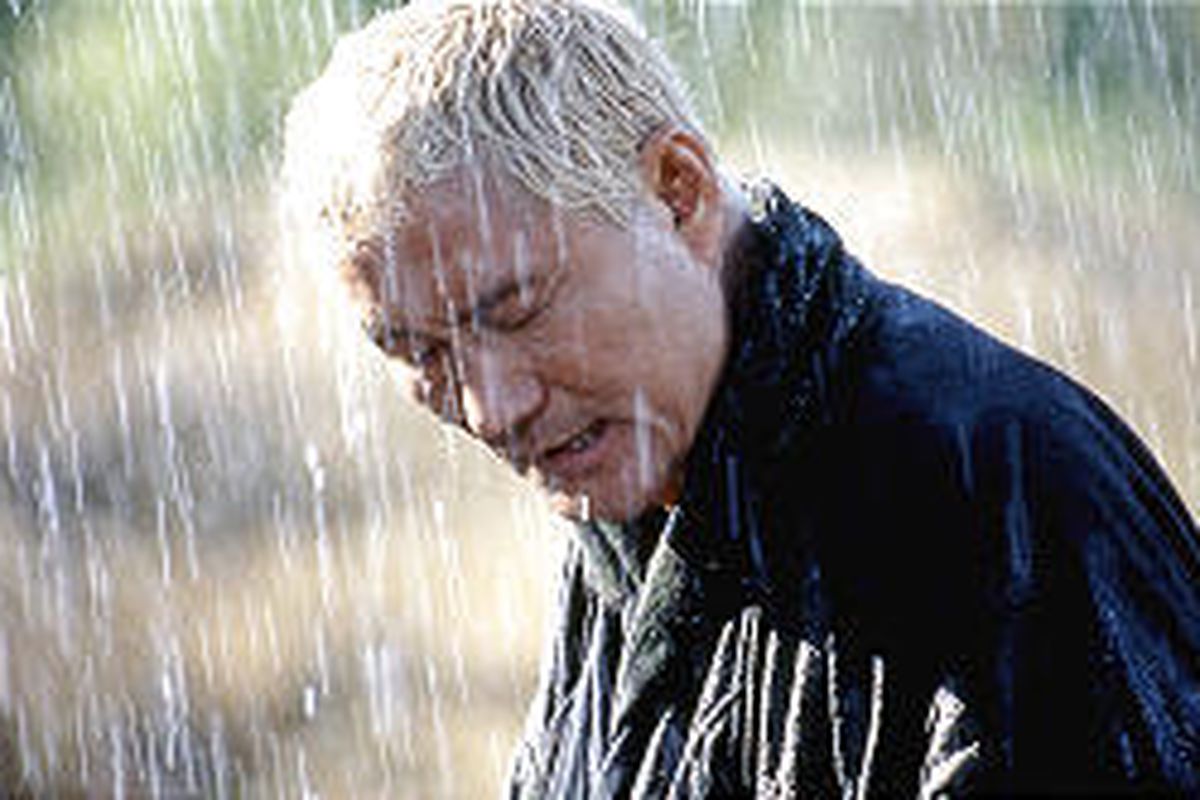By Chlotrudis Independent Film Society
Rating: 3.5 cats
Director: Takeshi Kitano
Starring: Beat Takeshi | Gadarukanaru Taka | Michiyo Ookusu | Michiyo Yasuda | Tadanobu Asano

Original language title: Zatôichi
Country: japan
Year: 2004
Running time: 116
IMDB: http://www.imdb.com/title/tt0363226/combined
Diane says: “Samurai spaghetti western with a heavy dose of MONTY PYTHON AND THE HOLY GRAIL. While samurai gangs destroy each other, Kitano shows what’s happening to the disenfranchised regular folks. Beat Takeshi, playing the lead role of THE BLIND SWORDSMAN, looked to me like Bill Murray in LOST IN TRANSLATION.
“Lots of laughs, lots of computer-generated spurting blood, great dance/music sequences; but I’m giving it only 2 or 3 cats. I don’t know enough about this genre to know what Kitano is trying to do, but it certainly lacks the heft of something like CROUCHING TIGER. On the other hand, peasants hoeing to a synthesized beat is really cool.”
Ned responds to Diane): “I can understand why one would want to compare ZATÔICHI to CROUCHING TIGER. On the surface they are relatively similar – big budget, historical Asian action films. They are even both homages to great film traditions of the past.
“However, this comparison does both films a disservice. ZATÔICHI’s source materials are inherently Japanese: the frequently character driven, reserved, mannered Samurai films of the 50s and 60s as well as the gore splattered explosions of violence that those films developed into during the late 60s and 70s. CROUCHING TIGER on the other hand has a quintessentially Chinese source: the great, moving martial arts epics of the Shaw Brothers. In addition, Ang Lee’s film was made expressly with a Western Audience in mind (consequently, the film flopped in Asia). Kitano’s film is made really for anyone but mostly for a Japanese audience that can appreciate his toying with the conventions and traditions of the samurai film.
“I’m trying not to geek out too much here, but I just wanted to reply quickly to Diane’s post. And not to get on her case because I see this as a common problem with American viewing of foreign cinema. It is often difficult for us (yes I’m guilty too) to perceive the differences in something that is so, well, foreign. And, granted, genre films walk some fine lines but basically making this comparison is a little bit like comparing a Sherlock Holmes film to a film noir. They may use many of the same conventions and elements but the genres themselves are fundamentally different.
“I’m sorry if I’m taking this all too far, if the film somehow failed to strike a chord with you that’s cool. I don’t think it’s a perfect film by any means. I just wanted to get some of my thoughts on this out there and maybe get a discussion started. I think we can all agree that the really great films transcend all borders and genres but I’m curious: How much preparation should one need to appreciate any given film?
“OK, discuss…
“BTW, my score for ZATÔICHI: Most of the film: 4 out of 5 whatevers, closing dance number 5 out of 5!”
Ivy responds to Ned: “I like the way you used Sherlock Holmes and Film Noir as a good correlation to the relationship between ZATOICHI and CROUCHING TIGER. Wait until all of you see HERO, and then there will be THREE Asian epics to compare!
“Remember to give Diane the credit that she admits that she might not know enough about the genre to know what Takeshi is getting at.”
Chris says: “I’m not an expert (or even much of a fan) of martial arts flicks, but I enjoy Takeshi ‘Beat’ Kitano’s work (or at least the two films of his I’ve seen: FIREWORKS and KIKUJIRO). His take on the classic Japanese serial about a blind samurai is as irreverent as you’d expect. Whereas HERO is a gorgeous, polished, painterly epic, Kitano’s film has a more wiry pulse: it’s a leisurely paced character study, equally devoted to intricately choreographed battle sequences and comic asides drenched in the director’s off-kilter sense of humor. Maybe too lesiurely-paced–to me, the film felt a little long and occasionally boring, but Kitano delivers a masterful, nuanced performance that’s never pretentious or austere. And the lively tap dancing sequence at the end won me over. Anachronistic? Sure, but it works in a convincing genre film that doesn’t take itself too seriously. 3.5 cats”
Tom says: “On my first viewing, I didn’t enjoy it that much, probably due to super-high expectations. On the second viewing, I was in love with it. Tap dancing = best movie ending EVER! Is Tadanobu Asano the actor of the year? Hell yes.”
Michael says: “Having never seen a Zatoichi film, I was quite taken by the combination of whimsy and gritty drama of THE BLIND SWORDSMAN: ZATOICHI. While in many ways a traditional samurai film, writer/director/star Takeshi Kitano (who has acted in many films including BATTLE ROYALE and TABOO, as well as directed such films as DOLLS and BROTHER) pushes on the borders of the genre to incorporate broad humor and, yes, a tap dancing finale. Visuals were terrific, as was the rhythmic use of sound. I too found the use of the cgi blood unusual… in some ways more realistic than many swordplay films with no blood at all… yet still somewhat jarring. I was particularly taken by the poignancy of the two geisha siblings bent on revenge of the slaughter of their family. Kitano doesn’t steer away from the horrors that they have endured, yet doesn’t dwell on it either. I enjoyed the way he incorporated flashbacks without any of the usual tricks to warn the audience. 4 cats”
